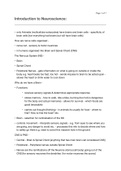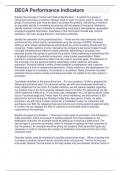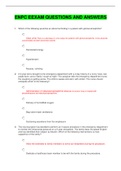Page 1 of 7
Introduction to Neuroscience:
• only Animalia (multicellular eukaryotes) have brains and brain cells - speci city of
brain cells [not everything had brains but will have brain cells]
How are nerve cells organised -
• nerve net - sensory & motor neurones
• in humans organised into Brain and Spinal Chord (CNS)
The Nervous System (NS) -
• Brain
• Spinal Chord
• Peripheral Nerves - gets information on what is going on outside or inside the
body e.g. heart beats too fast, too hot - sends impulse to brain to be acted upon -
slower the heart or drink water to cool down
Why do we have a Brain -
• Functions:
- receives sensory signals & determines appropriate response
- stores memory - how to walk, ride a bike, burning (too hot) is dangerous
for the body and actual memories - allows for survival - which foods are
good (enjoyable)
- carries out thought (thinking) - in animals its usually for food - where to
nd? How to nd the food? etc.
• Brain - selection for centralisation of the NS
• controls movement - interprets sensory signals - e.g. from eyes to see where you
are going, any danger to avoid etc. - processes this info to decide where and how
to safely go there e.g. need to avoid this massive hole in the ground
CNS & PNS -
• Central - Brain & Spinal Chord [anything that has main brain cell considered CNS]
• Peripheral - Peripheral nerves outside Spinal Chord
• Nerves are the rami cations o the Neurone stoma (cell body) going out of the
CNS [for sensory neurones the dendrites | for motor neurones the axons]
fi fi fi ff fi
, Page 2 of 7
Neural Organisation Chart -
PNS -
• convey…
- incoming info - Sensory
- outgoing info - Motor
• innervate/supply…
- somatic: relating to body - skeletal muscle or joints
- visceral: internal organs - autonomic
• motor neurones:
- control voluntary movement - activates skeletal muscles
- involuntary movement - re exes - can be reduced by voluntarily e.g.
tensing muscles
• visceral nerves form the Autonomic NS (ANS) which is divided into two…
1. Sympathetic - arouses body, emergency [not always emergency
situations e.g. waking up is sympathetic]
fl
Introduction to Neuroscience:
• only Animalia (multicellular eukaryotes) have brains and brain cells - speci city of
brain cells [not everything had brains but will have brain cells]
How are nerve cells organised -
• nerve net - sensory & motor neurones
• in humans organised into Brain and Spinal Chord (CNS)
The Nervous System (NS) -
• Brain
• Spinal Chord
• Peripheral Nerves - gets information on what is going on outside or inside the
body e.g. heart beats too fast, too hot - sends impulse to brain to be acted upon -
slower the heart or drink water to cool down
Why do we have a Brain -
• Functions:
- receives sensory signals & determines appropriate response
- stores memory - how to walk, ride a bike, burning (too hot) is dangerous
for the body and actual memories - allows for survival - which foods are
good (enjoyable)
- carries out thought (thinking) - in animals its usually for food - where to
nd? How to nd the food? etc.
• Brain - selection for centralisation of the NS
• controls movement - interprets sensory signals - e.g. from eyes to see where you
are going, any danger to avoid etc. - processes this info to decide where and how
to safely go there e.g. need to avoid this massive hole in the ground
CNS & PNS -
• Central - Brain & Spinal Chord [anything that has main brain cell considered CNS]
• Peripheral - Peripheral nerves outside Spinal Chord
• Nerves are the rami cations o the Neurone stoma (cell body) going out of the
CNS [for sensory neurones the dendrites | for motor neurones the axons]
fi fi fi ff fi
, Page 2 of 7
Neural Organisation Chart -
PNS -
• convey…
- incoming info - Sensory
- outgoing info - Motor
• innervate/supply…
- somatic: relating to body - skeletal muscle or joints
- visceral: internal organs - autonomic
• motor neurones:
- control voluntary movement - activates skeletal muscles
- involuntary movement - re exes - can be reduced by voluntarily e.g.
tensing muscles
• visceral nerves form the Autonomic NS (ANS) which is divided into two…
1. Sympathetic - arouses body, emergency [not always emergency
situations e.g. waking up is sympathetic]
fl











